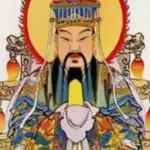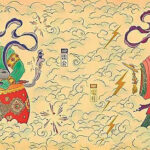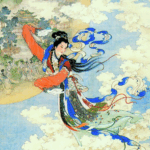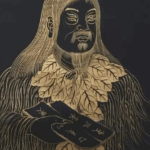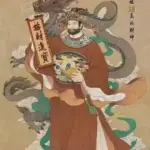In Chinese mythology, Di Jun (帝俊) is revered as an ancient celestial sovereign. He is the father of the ten Suns, whose simultaneous appearance in the sky nearly brought ruin to the Earth. The name “Di Jun” combines the character for “emperor” (帝, dì) with “handsome” or “elegant” (俊, jùn). He is said to have married both the solar goddess Xihe (羲和) and the lunar deity Changxi (常羲).
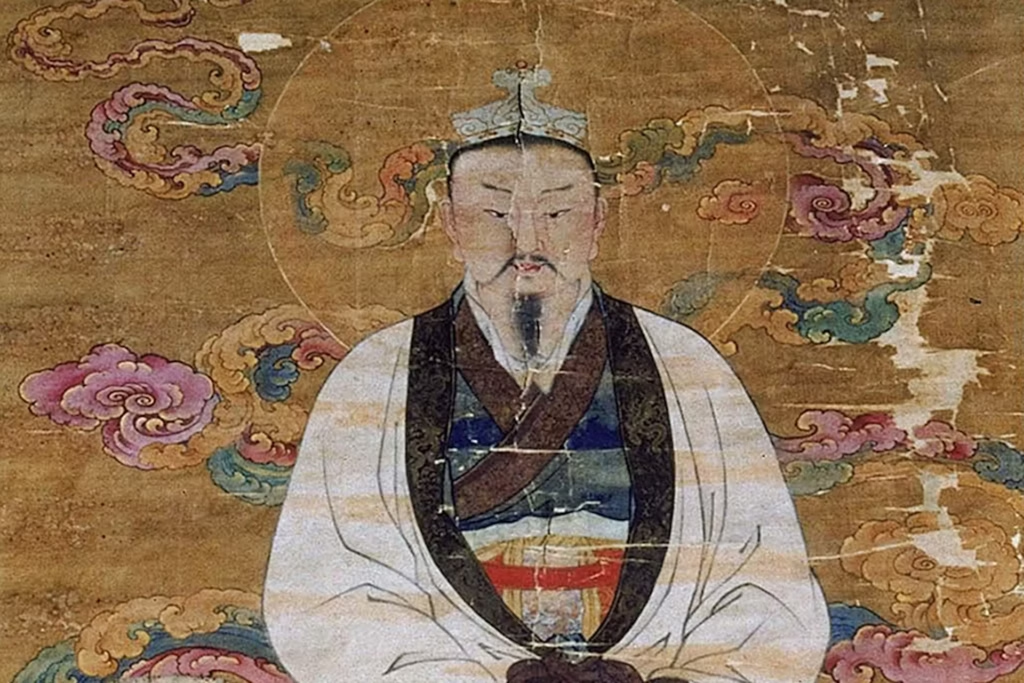
Known primarily through five chapters of the Shanhaijing (Yang 2005, 97), Di Jun (Chinese: 帝俊; pinyin: Dìjùn), also referred to as Emperor Jun, is among the pantheon of ancient Chinese supreme deities. His mythos includes two consorts—Xihe and Changxi—and spans numerous tales. One notable legend features the archer Hou Yi, to whom Di Jun bestowed a divine bow and arrows (Birrell 1993, 314). Di Jun is also intrinsically linked to agriculture, either as a cultivator himself or as the progenitor of figures like Houji, the Zhou dynasty’s legendary agricultural ancestor (Yang 2005, 98). Some scholars have suggested that Di Jun and Di Ku may be regional iterations of a single mythological archetype (Yang 2005, 100).
Portrayed in certain narratives as a treacherous and power-hungry figure, Di Jun is implicated in the betrayal and assassination of the Ancient Emperor of Heaven, his former master. His insatiable ambition to claim sovereignty over the divine realm ultimately drove him to commit this act of cosmic treason.
In a mythic epoch, ten Suns—offspring of Di Jun and Xihe—once coexisted in the sky. They had been commanded to appear one at a time, ensuring that Earth would not be scorched by their collective radiance. However, driven by childish mischief, they emerged together, unleashing an inferno upon the world. Forests ignited, famine spread, and the Earth’s crust blistered under the overwhelming heat. In response, the legendary archer Hou Yi (后羿) took it upon himself to restore balance. Di Jun, anguished by his sons’ disobedience and the resulting devastation, provided Hou Yi with the very arrows that would fell nine of the Suns.
Following the fragmentation of the Demon Emperor into five demonic essences, each essence assumed an independent form. Di Jun, having been sealed within an ancient formation in the void of outer space, was confined within the Ancient Pagoda—an apparatus reinforced by seven fragments of Northern Heaven Cold Star Iron. A sentient construct known as the Crocodile, forged from the primordial astral wind—a substance intimately connected to the essence of the wind element—served as guardian of this celestial prison.
Yunxiao journeyed to the outer void, seeking the astral wind to awaken the wind domain within his Divine Realm Tablet. Upon securing it, he was inadvertently drawn into the dimension of the sealing formation. Alongside the Starlight Soul Body of Yuan Gaohan, a ninth-tier alchemist, Yunxiao dismantled the formation to acquire the rare Cold Star Iron—thus releasing Di Jun.
As Yunxiao and Yuan Gaohan attempted to escape, Di Jun engaged the Crocodile in combat. With the aid of the Ancient Pagoda—referred to by Di Jun as the Battlefield of the Ancient Gods and in fact a fragment of a shattered supreme-grade weapon—he succeeded in subduing the guardian.
Later, Di Jun arrived in the Northern Region of the Heavenly Martial Continent, at Songyue Yan City, during a tournament held by the Merchant Union. By then, the city had already been devastated by the Demon Shang and his followers, with only a handful of high-ranking Union members surviving. In the ensuing conflict with Ding Shan, the Crocodile was split into two entities, forcing Di Jun to retreat.
Di Jun reemerges at the boneyard near the Blood God Palace, where another fragment of the Demon Emperor—known as “Di Ye”—remains sealed. There, he confronts Di Jia, who also seeks the hidden remnant.
Within the vast wilderness, there stands Mount Buting, where the Rong River comes to its end. There, a nation of three-bodied beings was born of Ehuang, consort of Di Jun. This people bore the surname Yao and subsisted on millet. They harnessed the power of four sacred birds. Around this domain lay deep abysses in each cardinal direction, with the north adjoining the Black River and the south opening to the Great Wilderness. To the north was the Abyss of Shaohe, and to the south, the Abyss of Cong—where Shun once bathed.
—Classic of the Great Wilderness: South
Beyond the southeastern seas, between the Gan Waters, lies the realm of Xihe. A maiden by the same name, Xihe, bathed the sun daily in the Gan Abyss. She was the wife of Di Jun and gave birth to the ten Suns.
—Classic of the Great Wilderness: South
In the depths of the Great Wilderness rose Mount Hexu, the point of emergence for both the sun and moon. From this place arose the kingdom of Zhongrong, begotten by Di Jun. The people of Zhongrong lived on the fruits of trees and the flesh of beasts, and employed four divine beasts—leopard, tiger, bear, and boar—as their emissaries.
In the land of Suyou, Di Jun begot Yanlong, who fathered Siyou. Siyou begot Sishi and Sinü, neither of whom took spouses. They fed on millet and wild game and likewise employed the four sacred beasts.
There existed the land of the White People, born of Di Jun’s descendant, Di Hong. The White People bore the surname Xiao, lived on millet, and commanded four spirit beasts—leopard, tiger, bear, and boar.
In the land of the Black Teeth, Di Jun fathered Heichi, of the Jiang lineage. They too consumed millet and employed the four divine beasts.
—Classic of the Great Wilderness: East
There were birds of five colors that migrated across sandy plains. Di Jun was said to dwell among them. Two altars were constructed beneath him, and the multicolored birds served as his messengers.
—Classic of the Great Wilderness: East
A woman was seen bathing beneath the moonlight. She was Changxi, wife of Di Jun, who bore twelve moons. It was there that they were first bathed.
—Classic of the Great Wilderness: West
The Yellow Emperor begot Luoming, who fathered the White Horse, later known as Gun. Di Jun fathered Yuhao, who begot Yinliang, progenitor of Fanyu, the first to craft boats. Fanyu fathered Xizhong, who begot Jiguang, inventor of the wooden chariot. Shaohao begot Ban, the originator of bows and arrows. Di Jun bestowed upon Hou Yi a crimson bow and white-feathered arrows to aid the mortal realm. Hou Yi used them to alleviate the sufferings of the Earth. Di Jun also begot Yanlong, the originator of the qin and se (zither and lute). Di Jun’s eight sons were the first to compose songs and perform dances.
From the three-bodied progeny of Di Jun arose Yijun, the first carpenter, who taught the people to shape wood into tools. Hou Ji pioneered the cultivation of grains. His grandson, Shujun, was the first to harness oxen for plowing. The state of Chiyin marked the beginning of organized governance. Yu and Gun were the first to map the land and define the Nine Provinces. The Emperor then commanded Yu to complete the great task of dividing and regulating the terrain.
—Classic of the Lands Within the Seas
From ancient times came the tale of the bear-hail beast, whose origin is obscured. It dwelled upon the rugged ridges of a sacred mountain, its people marked by ink-dark eyes and no heraldry. Their waters were misty, and their days governed by wind and rain. The child of a certain being, called Nü Tian, gave birth to four children. Each took on duties of governance. When Heaven and Earth were yet undefined, and chaos reigned, these beings brought order. They established domains, named the directions, and transformed the landscape.
The days were long and unmeasured, without sun or moon. The Four Spirits took turns in governing the heavens, thereby initiating the reckoning of time and the establishment of seasons.
Of the four ruling spirits, one was known as the Azure Gan; another, the Vermilion Tan; the third, the Yellow Ran; and the last, the Black Gan. After millennia, the sun and moon were born. Yet the Nine Provinces remained uneven, and the mountains trembled with blood-soaked storms. The Four Spirits, therefore, brought forth equilibrium and raised the sky’s edges. To guard against further chaos, they chose sacred woods—green, red, yellow, white, and black—as their sentinels.
The Flame Emperor charged Zhu Rong to descend with the Four Spirits and anchor the three celestial pillars. He commanded the establishment of the four extremities, declaring, “If not under the dominion of the Nine Heavens, the earth shall fall to chaos; thus, no mortal shall dare defy the divine order.” Di Jun then delineated the courses of the sun and moon.
During the era of Gong Gong, who battled Kuafu across ten suns, the Four Seasons fell into disarray. The deities of wind, rain, and stars created confusion. Di Jun reversed the paths of the sun and moon, instituted the calendar, and ensured the return of dawn, dusk, day, and night.
—The Silk Manuscript of Chu


